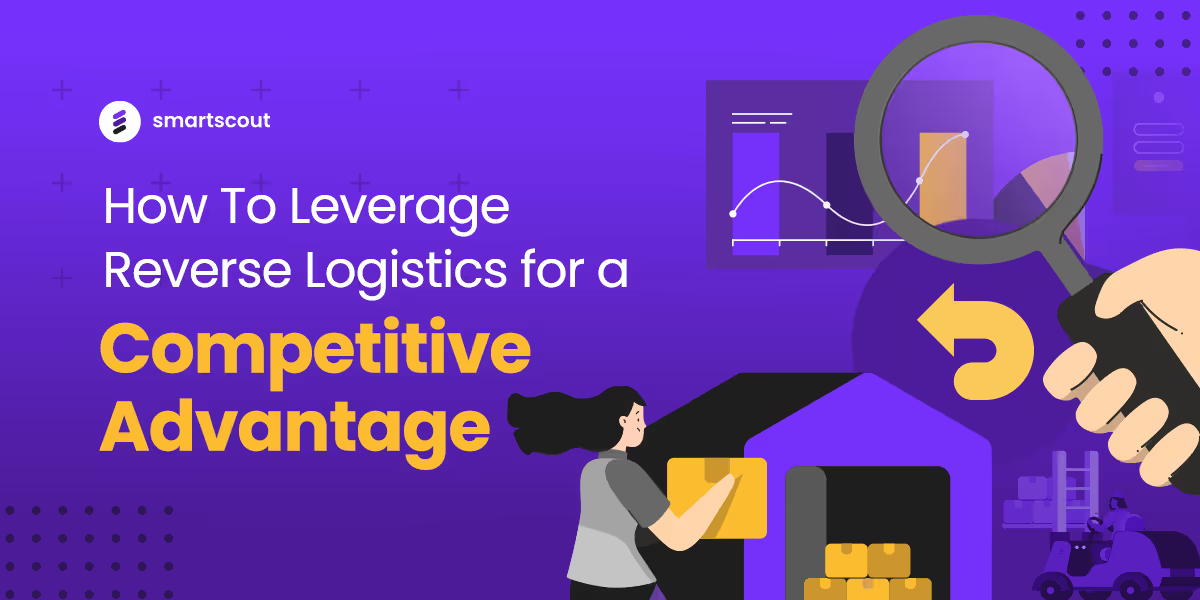Reverse logistics is an area retailers often overlook in their eCommerce supply chain. While it’s a back-end process that isn't as glamorous as acquisition or sales, you can’t underestimate its impact on your business's bottom line, customer satisfaction, and sustainability.
Reverse logistics involves managing returns, restocking products, and facilitating robust customer service. It’s far from straightforward, often presenting numerous challenges that can strain an operation's resources.
However, by following tried-and-tested practices, you can lessen the headache and even transform that profit loss into business gain.
Keep reading to learn how to leverage reverse logistics to strengthen your operational efficiency and secure a competitive advantage.
What Is Reverse Logistics?
Far from being mere corporate jargon, reverse logistics is a critical element that drives operational efficiency, customer satisfaction, and even sustainability in modern business dynamics.
In its simplest form, reverse logistics is the flow of goods in the opposite direction of typical logistics, hence the term “reverse.” Once a sold product reaches the customer, any operation that occurs afterward — be it refurbishments, recycling, or disposal — falls under the umbrella of reverse logistics.
The Typical Reverse Logistics Process
Online purchases tend to take a similar journey:
- A customer visits an online store, browses the inventory, and selects a product to purchase.
- The order is processed, packed, and dispatched, then eventually arrives at the customer's doorstep.
This is the forward flow of logistics, a process that businesses have spent years refining. But what happens when the customer is dissatisfied with their purchase? The product may not match the description, may be the wrong fit, or is defective. So, the customer decides to return the product, and that triggers the reverse logistics process:
- The returned product is collected from the customer, transported back to the warehouse or returns center, and logged. As the first stage in reverse logistics, efficiency in transportation and handling is crucial to minimize costs and manage customer expectations.
- Upon arrival, the product undergoes inspection and sorting. Specialists assess the product's condition and determine whether it's fit for resale. The product might need repairing, cleaning, or repackaging to be restored to a sellable state.
Each step in the reverse shipment process entails careful management to ensure resources are used effectively and the product can reenter the sales cycle as swiftly as possible.
However, not all returned products can be resold. If an item is deemed unfit for resale, it has to be disposed of, which is more involved than simply tossing it into a bin. The product needs to be recycled responsibly or, in some cases, safely disposed of. This is another critical aspect of reverse logistics and is particularly important for businesses focusing on greater sustainability.
Benefits of Efficient Reverse Logistics
It takes time and effort to hone your reverse logistics, but the ensuing rewards are substantial and far-reaching. If you can master this typically cost-centric operation, your business can enjoy many benefits.
Improved Customer Satisfaction
A smooth, hassle-free returns process can significantly enhance the customer experience. It demonstrates your business's commitment to buyer satisfaction and contributes to long-term consumer relationships. In the eCommerce industry, this can be a significant differentiator.
Reduced Costs
Efficient reverse logistics reduces transportation, storage, and disposal costs. Further, quick turnarounds on returns lower storage needs, and efficient sorting and inspection can cut labor costs.
Sustainable Practices
With consumers becoming more environmentally conscious, businesses are pressured to adopt sustainable practices. A robust reverse logistics process that incorporates responsible recycling or disposal of products can help businesses meet these expectations and reduce their environmental footprint.
Recovery of Value
A streamlined returns process can quickly recover value from goods sent back, whether by returning them to inventory for resale, refurbishing them for secondary markets, or recycling components. This can turn potential losses into alternative revenue.
Insightful Data
A well-managed reverse logistics process provides valuable data on return patterns and trends. You can then use this information to improve product quality, packaging, transportation, or even to revise your return policy.
Enhanced Reputation
A business that handles returns efficiently, respects the environment, and values customer satisfaction is better positioned to build a positive reputation in the marketplace. That, in turn, attracts new customers and retains existing ones, leading to sustainable growth.
By optimizing reverse logistics, businesses can transform what is often seen as a burdensome obligation into a competitive advantage. When executed well, it manages costs and opens up opportunities for added value, sustainability, and customer retention.
Common Reverse Logistics Challenges
Successfully implementing an efficient reverse logistics strategy is challenging. Each stage presents its own complexities, making it difficult for businesses to reap the full benefits of this essential process.
Handling Returns
Unfortunately, returns are inherent in eCommerce, and dealing with them can be complex and consume resources. Each return needs to be logged, tracked, and processed, which can be intensive given the high return rate in online retail. Managing this volume effectively is essential to prevent logistical bottlenecks and maintain customer satisfaction.
Restocking
Once a product is returned, it must be inspected, sorted, and, if applicable, returned to inventory as soon as possible. That requires careful coordination between various teams and resources. Delays in this process can lead to inventory pile-up, potential depreciation of products, and lost sales opportunities.
Customer Service
A crucial aspect of reverse logistics is interacting with buyers about their returns. Customer service is the channel that explains your return policy and process for handling queries and complaints. Providing prompt and satisfactory responses is often difficult, particularly during peak return periods.
Visibility and Tracking
With numerous returns to process, keeping track of each item can be an uphill task. Businesses need to have a clear view of their return pipeline to manage resources effectively and keep customers informed about the status of their returns.
Quality Control
Identifying the reason for a product's return and evaluating its condition accurately is critical. This process can be time-consuming and prone to errors though, especially when dealing with large volumes of returns.
Environmental Impact
Due to the increasing focus on sustainability, businesses must consider the environmental impact of their reverse logistics. That entails responsibly recycling or disposing of products that can’t be resold, which can be complicated and costly.
Cost Management
Every step in the reverse logistics process has associated costs, from transportation and labor to warehousing and disposal. Balancing these expenses while maintaining high levels of customer service can be a significant challenge for many businesses.
These challenges underscore the complexity of reverse logistics and the need for robust strategies and tools to manage them effectively. Businesses equipped to overcome these challenges can transform potential negatives into cost-saving, customer-retaining opportunities.
Reverse Logistics Best Practices
Fine-tuned reverse logistics is the product of deliberate strategies, careful planning, and constant optimization. As you navigate this complex set of tasks, here are some best practices to guide you toward greater efficiency and reduced costs.
Establish Clear Return Policies
More than 60% of customers read a company’s return policy before purchasing.
Detailed, easy-to-understand policies manage customer expectations and prevent unnecessary returns. They guide customers on how to return a product, which reduces the chances of damage during transit. Ensure your policy is transparent about what items can be returned, the condition they must be in, and the timeframe for eligible returns.
Optimize Inspection and Restocking Processes
A well-honed reverse logistics operation requires swift inspection and restocking; every moment a product is unavailable for resale, you lose potential profit.
Businesses can expedite this process by investing in well-trained inspection teams and efficient restocking procedures. Also, consider automation tools that can speed up product sorting and restocking.
Invest in Customer Service Training
A well-trained customer service team can drastically improve the consumer experience during returns. Training should focus on soft skills such as communication and empathy, as well as technical knowledge of the returns process to resolve queries quickly and accurately.
Maintain Detailed Returns Records
Detailed records of returns can provide valuable insights into patterns and trends. You can use this data to identify common reasons for returns and guide improvements in product quality, packaging, or even altering your return policy.
Incorporate Return Minimization Strategies
While robust logistics is crucial, minimizing returns in the first place is equally important. To mitigate their occurrence, look into improving product descriptions and images, offering accurate sizing information, or enhancing quality control measures.
Plan for End-of-Life Products
Not all returned products can be resold. For those cases, develop a plan for products’ end of life that includes responsible recycling or disposal. Partnering with a certified e-waste recycler is an excellent way to ensure your business's sustainability.
Leverage Technology
Manual processes can quickly become overwhelming and prone to errors as your operation grows. Embrace automation and machine learning to streamline your reverse logistics and ease the burden on your shoulders. Whether it's an all-in-one solution or a selection of specialized tools, technology plays a major role in optimizing your reverse logistics.
For example, MyFBAPrep offers comprehensive solutions designed to address reverse logistics challenges. It allows businesses to track and manage returns effectively, simplifying restocking and even automating customer interactions related to returns. Integrating this kind of tool into your process can reduce manual effort, improve accuracy, and accelerate return processing.
Final Thoughts
Reverse logistics is much more than a post-sale to-do list. It's a rich opportunity to enhance customer satisfaction, cut costs, and reduce your business’s environmental impact.
While managing this process can be difficult, with strategic planning and the right tools, you can transform these challenges into growth. If you haven't reassessed your reverse logistics strategy recently, now’s the time.
A well-executed procedure can bring financial gains, customer loyalty, and sustainability — a winning combination in the competitive landscape of eCommerce.











